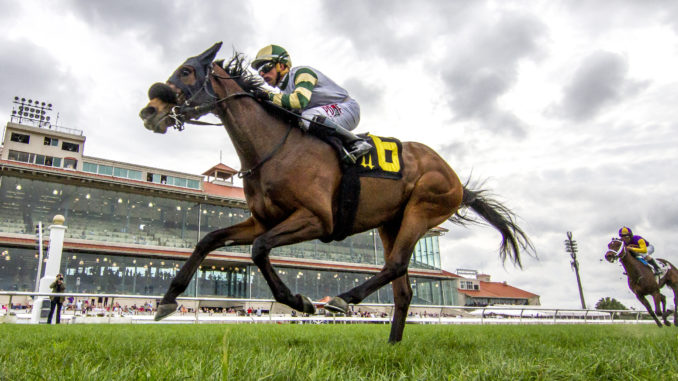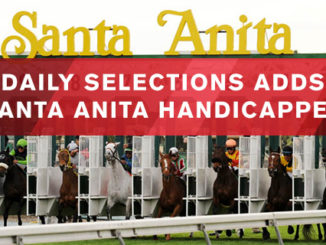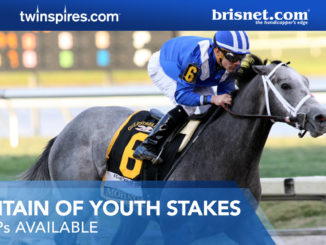
Playing the superfecta from “Top-to-Bottom”
Original piece by Gary Hall re-printed from the ALL-Ways handicapping newsletter, January 2001
We always look forward to what we consider to be “playable” superfectas. There generally is at least one good play on a card and many tracks are offering this wager on more and more races. This makes it easier to be patient and selective in the races we play.
The superfecta, which is much easier to hit than the Pick 6, clearly offers the opportunity for big scores with payoffs frequently in the thousands of dollars and sometimes even tens of thousands. In the 2000 Breeders’ Cup, all five superfectas on the card paid $5,000 or more (based on a $1 wager), including the whopping $99,813 payoff in the Turf (G1).
As another example, just before sending this newsletter to print, this author hit back-to-back superfectas at Turfway Park. The $2 payoffs were $4,378 and $6,239 respectively. We had $1 tickets.
In this article, we are going to explore four different areas that will help point us in the right direction for playing this wager successfully. We will cover:
- 1. Top heavy tickets
- 2. When to pass or play
- 3. How to reduce combinations wagered
- 4. Handicapping for 3rd and 4th place
Top heavy tickets
Ask yourself, “Is it easier to handicap for win and place horses or is it easier to handicap for the third- and fourth-place finishers?”
The answer, of course, is that it is much easier to handicap for the top two finishers. Now, consider one very popular way to play the superfecta. Here is what the ticket would look like.
ABC / ABCD / ABCDE / ABCDEF
A $1 superfecta ticket of this type costs $81. Actually, in the right circumstances, this ticket makes sense. Indeed, we have played it successfully on more than one occasion. However, more often than not, we would consider this to be a “Top heavy” ticket.
Now, consider the following ticket.
AB / ABC / ABCDEFG / ABCDEFG
A $1 superfecta with this ticket costs $80, about the same as the “Top Heavy” ticket. However, this ticket has horse “F” in the third position in addition to the fourth slot, and it has added horse “G” to both the third and fourth slots.
What we have done is to remove some combinations at the top of the ticket, which are easier to handicap, in favor of adding more combinations on the bottom of the ticket, which are more difficult to handicap. So, one of our recommendations is to move some combinations from “Top to Bottom.” More on this later.
When to Pass or Play
More often than not, the superfecta should be passed. It is very important to be selective. This is a high-risk bet and you should play it only if you have the opportunity for a big payoff. There are two simple rules we follow to determine if we will pass or play the superfecta.
- 1. The underlying trifecta must be playable.
- 2. The post-time favorite must be, in our opinion, a false favorite. We must be convinced the favorite will not win.
To determine if the underlying trifecta is playable, we use the chart below which we first presented in our July 1997 Newsletter.
Pass or play the trifecta
| Favorite ITM | Long odds ITM | Pass or Play | ||
| yes | no | pass | ||
| yes | yes | play | ||
| no | no | play | ||
| no | yes | crush |
When we refer to a “long odds” horse, we are referring to horses that are going off at 10-1 or higher, the higher the better, of course. The trifecta is not playable if the favorite figures to finish in-the-money and no long-odds horse figures to finish in-the-money. Otherwise the trifecta is generally playable, including the probability of high payoffs, when the favorite figures to finish off-the-board.
To repeat: We will play the superfecta ONLY if the trifecta is playable AND the favorite is a false favorite.
Reducing the number of combinations
There are good ways to reduce the number of combinations you play in your superfecta ticket. This will reduce the cost of the ticket. You can pocket the dollars you save or you may want to reinvest them to add additional horses on the bottom of the ticket (moving combinations from top to bottom).
Let’s look at techniques for reducing combinations. We will relate these back to the common superfecta ticket presented earlier. Here is that $81 ticket for a $1 Superfecta.
ABC / ABCD / ABCDE / ABCDEF
There are two key methods of reducing the number of combinations or moving combinations from top to bottom.
- 1. Trifecta plus
- 2. Key horse with required finish
Trifecta plus
In our July 1997 ALL-Ways Newsletter, in the second part of our series on playing the trifecta, we introduced the concept of developing your trifecta ticket by first developing an exacta ticket. We showed how to take an exacta ticket of AB/ABC and turn it into a trifecta ticket of AB/ABC/ABCDE. You might want to go back and look at the newsletter. It has some very good ideas for selecting these horses.
Now, what we are saying regarding the superfecta, is to take this trifecta ticket and turn it into a superfecta ticket. It might look like this.
AB / ABC / ABCDE / ABCDEF
This reduces the wager from $81 to only $36 and we have added Horse F into the wager, now covering a total of six horses in the race. You have a choice at this point. You can pocket the savings in the cost of the wager or you can add additional combinations to the bottom of the ticket. For example, the ticket below adds horses “G”, “H” and “I” to the fourth slot.
AB / ABC / ABCDE / ABCDEFGHI
This ticket costs $72 but now covers nine horses in the race.
Again, we suggest you read the July 1997 Newsletter. It will be very helpful constructing a trifecta plus ticket. You can view/print the newsletter from the All-Ways data files page at Brisnet.com which has a link to the newsletter archive.
Key horse with required finish
Very simply, this requires that we select one of the top horses as our key horse. This is a horse that we feel confident will finish in the top three. What we are really hoping for in the superfecta is for the crowd favorite to finish off the board. So, the crowd favorite must never be our key horse.
Here is what the ticket above would look like if we select horse “A” as our key horse. Actually, it is three tickets, one for each of the possible finishing positions of the key horse.
| Ticket | $1 Cost | |
| A / BC / BCDE / BCDEFGHI | $36 | |
| B / A / CDE / CDEFGHI | $18 | |
| B / C / A / DEFGHI | $6 |
By using a key horse, we reduce the total cost to just $60. We can either pocket this savings or we can invest it to put more horses in the third and/or fourth spot. For example, we could add two more horses to the fourth slot as shown below.
| Ticket | $1 Cost | |
| A / BC / BCDE / BCDEFGHIJK | $48 | |
| B / A / CDE / CDEFGHIJK | $24 | |
| B / C / A / DEFGHIJK | $8 |
This gets us back to an $80 ticket, but the ticket covers 11 horses in the field. Stop and think now how far we have come. We started with an $81 ticket that covered six horses. We now have an $80 ticket that covers 11 horses. We did this by moving combinations from the top half of the ticket (which is easier to handicap) to the bottom half of the ticket (which is difficult to handicap) and by requiring that we select one horse in the race (not the favorite) to finish either first, second or third.
We are not suggesting that all your superfecta tickets include 11 horses. Indeed, the $6,239 Superfecta in the 5TH at Turfway had only eight horses in the race. What we are suggesting is that you construct your wager such that you have fewer combinations in the win and place slots in favor of more combinations in the third and fourth slots.
Handicapping for third and fourth place
It is very difficult to handicap for the third-place finisher and even more difficult for the fourth-place finisher. That is why we have spent so much time figuring out how to get more horses into our wager at the bottom of the ticket. There are, however, some very good handicapping factors in ALL-Ways software that have proven to be effective for selecting these horses, namely Final Fraction Pace figures and Combined Pace ratings.
Dangerous non-contenders
After ALL-Ways software automatically selects contenders in a race, it looks at each remaining horse to see if it can spot anything that may make it “dangerous” in today’s race.
If it finds something, it designates the horse as a dangerous non-contender. We suggest you include such horses in the bottom part of your superfecta ticket.
The ALL-Ways Paceline Report is great for handicapping superfecta plays. In addition to fundamental class, speed and comprehensive figures, it includes all pace figures and track bias statistics. Contenders and dangerous non contenders are highlighted as well.
Class and layoffs
Low class horses and long layoff horses do indeed often finish third or fourth. So, we do not eliminate such horses. If we just have too many horses for our ticket and feel we must eliminate one or two of these kinds of horses, be sure NOT to eliminate horses with good Back Speed or good Back Class.
Summary
A few years back, a new ALL-Ways handicapper with a young family and modest means telephoned to thank us for a wonderful Christmas present. He had bet a straight $2 superfecta ticket using ALL-Way software’s first four picks in exact order. He won the superfecta with a $10,000 payoff. Like the television commercial says, “I love my job!”
Obviously, superfectas usually require that we bet a number of combinations. We hope this article helps you to decide which superfectas to play and which to pass and how best to craft your tickets.



